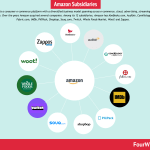Amazon Subsidiaries

Amazon is a consumer e-commerce platform with a diversified business model spanning across e-commerce, cloud, advertising, streaming, and more. Over the years Amazon acquired several companies. Among its 12 subsidiaries, Amazon has AbeBooks.com, Audible, CamiXology, Fabric.com, IMDb, PillPack, Shopbop, Souq.com, Twitch, Whole Foods Market, Woot! and Zappos.
[image error]Amazon has a diversified business model. Amazon’s primary revenue streams comprise its e-commerce platform, made of Amazon labeled products and Amazon third-party stores. In addition to that, Amazon makes money via third-party seller services (like fulfilled by Amazon), advertising on its platform, AWS cloud platform, and Prime membership.
[image error]Amazon has a diversified business model. In 2018 Amazon posted over $232 billion in revenues and over $10 billion in net profits. Online stores contributed to nearly 52% of Amazon revenues, followed by Physical Stores, Third-party Seller Services, Amazon AWS, Subscription Services, and Advertising revenues.
[image error]A company like Amazon has multiple value propositions, as it serves several target customers in different markets. With its mission “to be Earth’s most customer-centric company, where customers can find and discover anything they might want to buy online and endeavors to offer its customers the lowest possible prices,” Amazon value propositions range from “Easy to read on the go” for a device like Kindle, to “Sell better, sell more” to its marketplace.
[image error]The cash conversion cycle (CCC) is a metric that shows how long it takes for an organization to convert its resources into cash. In short, this metric shows how many days it takes to sell an item, get paid, and pay suppliers. When the CCC is negative, it means a company is generating short-term liquidity.
[image error]Amazon mission statement is to “serve consumers through online and physical stores and focus on selection, price, and convenience.” Amazon vision statement is “to be Earth’s most customer-centric company, where customers can find and discover anything they might want to buy online, and endeavors to offer its customers the lowest possible prices.”
[image error]The Amazon Flywheel or Amazon Virtuous Cycle is a strategy that leverages on customer experience to drive traffic to the platform and third-party sellers. That improves the selections of goods, and Amazon further improves its cost structure so it can decrease prices which spins the flywheel.
More about Amazon:
Amazon Business ModelWhat Is the Receivables Turnover Ratio? How Amazon Receivables Management Helps Its Explosive GrowthAmazon Case Study: Why from Product to Subscription You Need to “Swallow the Fish”What Is Cash Conversion Cycle? Amazon Cash Machine Business Model ExplainedWhy Is AWS so Important for Amazon Future Business Growth?Amazon Flywheel: Amazon Virtuous Cycle In A NutshellAmazon Value Proposition In A NutshellWhy Amazon Is Doubling Down On AWSThe Economics Of The Amazon Seller Business In A NutshellHow Much Is Amazon Advertising Business Worth?What Is the Cost per First Stream Metric? Amazon Prime Video Revenue Model ExplainedJeff Bezos Teaches You When Judgment Is Better Than Math And DataAlibaba vs. Amazon Compared in a Single InfographicAmazon Mission Statement and Vision Statement In A Nutshell
Read More:
Business ModelsPlatform Business ModelsDigital Business ModelsDistribution ChannelsBusiness StrategyValue PropositionMarketing StrategyBrand BuildingSWOT Analysis
The post Amazon Subsidiaries appeared first on FourWeekMBA.
Published on October 21, 2020 13:25
No comments have been added yet.



